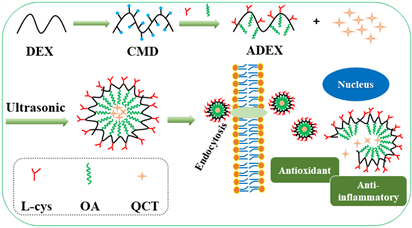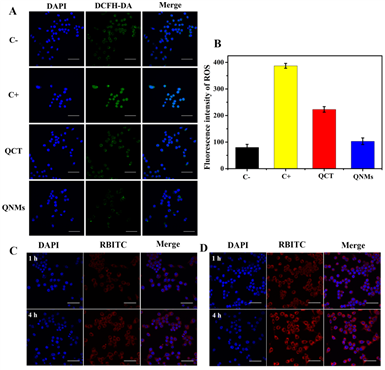Recently, the Dry Farming New Materials Laboratory of the South Subtropical Crops Research Institute of the Chinese Academy of Tropical Agricultural Sciences has made new progress in the field of new materials for nano sustained and controlled release drug carriers. This study systematically explained the key mechanism of drug loaded nano micelles in improving the stability of hydrophobic drugs and cell uptake efficiency from the aspects of the synthesis of amphiphilic nano micelle wall materials, the preparation of drug loaded nano micelles and their characterization of structure and performance, and the anti-inflammatory and antioxidant effects of drug loaded nano micelles.
The physical and chemical stability and physiological activity of macromolecular drugs are closely related to their molecular structures, but their specific molecular structures lead to a significant decline in their water solubility, which seriously affects their applications in medicine, cosmetics or functional food and other fields. Take quercetin (QCT) as an example. It is one of the most important flavonoids in human daily diet. However, QCT has a two-dimensional molecular structure with multiple active hydroxyl groups, which makes it poorly water-soluble, thus limiting its wide application. Polymeric drug micellar carriers have good stability, strong drug loading capacity and small particle size, which can improve the water solubility of drugs while maintaining their physiological activity. They are a kind of potential drug delivery systems. On the basis of the team's previous research, this study used chemical coupling method to graft sulfhydryl small molecule L-cysteine and hydrophobic chain octadecylamine onto the side chain of carboxymethyl glucan to synthesize amphiphilic double grafted glucan derivatives. Then, using modified glucan as wall material and quercetin as core material, quercetin drug loaded nanomicelles (QNMs) were prepared by ultrasonic self-assembly, While maintaining the physiological activity of quercetin, it significantly improved its water solubility, light stability and cell uptake efficiency. The results show that QNMs can be slowly released in simulated gastric juice and simulated intestinal juice, and the in vitro sustained release mechanism conforms to the non Fickian model. Compared with QCT original drug, the light stability of QCT was increased by 58.13% by nano encapsulation, which made it have better ability to scavenge PTIO ·, · OH and · O2 free radicals, and can effectively lower the expression of proinflammatory factors and up regulate the expression of anti-inflammatory factors. Among them, the wall material modified by thiolation plays an important role in improving the cell uptake efficiency of QNMs. This study has important theoretical significance for the research and development of new hydrophobic drug formulations, and provides technical support for the development of nano medicine, nano pesticide, nano veterinary drug, nano preservative and nano cosmetics.

Synthesis mechanism of amphiphilic dextran and drug loaded nano micelles; Anti inflammatory and antioxidant effects of drug loaded nano micelles.

Effects of QCT and QNMs on ROS production in LPS induced RAW264.7 macrophages (A, B); Results of cell uptake of QCT (C) and QNMs (D) by RAW264.7 macrophages.
This research achievement was published in the International Journal of Biological Macroeconomics as "Dual graded dextran based nanometers: Higher antioxidant, anti flammatory and cellular take efficiency for quercetin". He Zuyu, Assistant Researcher of the South Asia Institute of CATAS, and Liu Yunhao, Assistant Researcher, are the co first authors of the paper, and Li Puwang and Yang Ziming, Associate Researchers, are the co corresponding authors of the paper. This research has been supported by Hainan Natural Science Foundation Program (No.421MS078, 221QN0920), the central level basic scientific research business fee (No.1630062022016, No.1630062022022022023), the national key research and development plan (No.2020YFD1000604), Zhanjiang Science and Technology Plan Project (No.2020A03018) and other funds.


